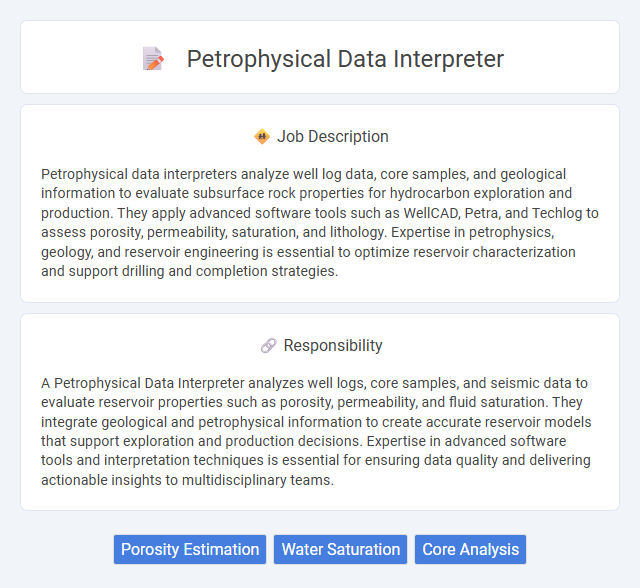
Petrophysical data interpreters analyze well log data, core samples, and geological information to evaluate subsurface rock properties for hydrocarbon exploration and production. They apply advanced software tools such as WellCAD, Petra, and Techlog to assess porosity, permeability, saturation, and lithology. Expertise in petrophysics, geology, and reservoir engineering is essential to optimize reservoir characterization and support drilling and completion strategies.
Individuals with strong analytical skills and a keen interest in geology or engineering are likely suitable for a Petrophysical Data Interpreter role. The job may demand working with complex datasets and interpreting subsurface properties, which could be challenging for those uncomfortable with data analysis or detailed technical work. Candidates who enjoy problem-solving and can maintain focus under pressure may have a higher probability of thriving in this position.
Qualification
Expertise in geology, geophysics, or petroleum engineering is essential for a Petrophysical Data Interpreter, along with proficiency in software such as Techlog, Petrel, or Interactive Petrophysics (IP). Strong analytical skills and a deep understanding of well logs, core analysis, and reservoir characterization enable accurate formation evaluation and fluid identification. Advanced qualifications often include a bachelor's or master's degree in relevant fields and experience with data integration and interpretation in complex reservoirs.
Responsibility
A Petrophysical Data Interpreter analyzes well logs, core samples, and seismic data to evaluate reservoir properties such as porosity, permeability, and fluid saturation. They integrate geological and petrophysical information to create accurate reservoir models that support exploration and production decisions. Expertise in advanced software tools and interpretation techniques is essential for ensuring data quality and delivering actionable insights to multidisciplinary teams.
Benefit
Petrophysical data interpreters likely enhance reservoir characterization by accurately analyzing subsurface rock properties, which may improve drilling efficiency and reduce operational risks. Their expertise probably contributes to better decision-making in hydrocarbon exploration, leading to cost savings and increased production. Proficiency in interpreting petrophysical data potentially supports the optimization of resource extraction strategies, benefiting overall project outcomes.
Challenge
The role of a Petrophysical Data Interpreter likely involves analyzing complex geological and reservoir data, which presents challenges due to the variability and uncertainty inherent in subsurface formations. Accurately integrating diverse data sources such as well logs, core samples, and seismic data may require advanced technical skills and experience with specialized software. Continuous adaptation to new technologies and evolving industry standards might be essential for effective interpretation and meaningful insight generation.
Career Advancement
A Petrophysical Data Interpreter specializes in analyzing subsurface rock properties to optimize hydrocarbon extraction, leveraging advanced software and geophysical techniques. Expertise in reservoir characterization and data integration enhances career progression towards roles such as Senior Petrophysicist, Reservoir Engineer, or Data Science Specialist within the energy sector. Continuous skill development in machine learning applications and digital oilfield technologies significantly accelerates upward mobility and leadership opportunities.
Key Terms
Porosity Estimation
Petrophysical data interpreters specialize in analyzing subsurface rock properties to estimate porosity accurately, essential for reservoir characterization and hydrocarbon volume calculations. Utilizing advanced well log data such as neutron, density, and sonic logs, they apply cross-plotting and empirical models to determine pore space distribution. Their expertise enhances reservoir quality assessment, driving informed decision-making in exploration and production engineering.
Water Saturation
A Petrophysical Data Interpreter specializing in Water Saturation analyzes well log data to determine fluid distribution within reservoir rocks, using resistivity and porosity measurements to estimate the volume of water versus hydrocarbons. Accurate interpretation of water saturation is critical for reservoir characterization, influencing decisions on production strategy and hydrocarbon recovery. Expertise in software tools like PetroMod and Schlumberger's Techlog enhances the precision of water saturation modeling, optimizing reservoir management and economic evaluation.
Core Analysis
A Petrophysical Data Interpreter specializing in Core Analysis evaluates rock samples to determine porosity, permeability, and fluid saturation, which are critical for reservoir characterization. Utilizing advanced software and laboratory data, they translate core plug measurements into actionable insights, guiding drilling and production strategies. Expertise in petrophysics, geology, and data integration ensures accurate formation evaluation and optimized hydrocarbon recovery.
 kuljobs.com
kuljobs.com